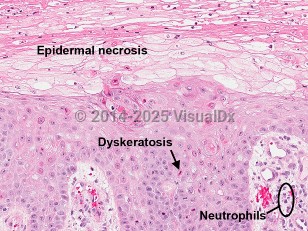Necrolytic acral erythema
Alerts and Notices
Important News & Links
Synopsis

Necrolytic acral erythema (NAE) is a rare cutaneous disorder associated with hepatitis C virus (HCV) and first described in 1996. NAE is unique among necrolytic erythemas for its acral distribution and association with HCV. The prevalence of NAE in HCV patients is about 1.7%.
The pathophysiology of NAE is poorly understood.
The mean age at diagnosis is 40 years old (range 11-76 years old), 60% of patients are female, and a majority of afflicted individuals are African (including Egyptian) or African-American. Patients presenting with NAE often have advanced hepatic fibrosis or chronic hepatitis. Pediatric cases are rare, attributed to the lower rates of HCV among children compared with adults, although the presentation of NAE in children is similar to that of adults.
NAE initially presents with pronounced erythematous papules and occasional vesicles and flaccid bullae; the papules become confluent over time and progress to well-demarcated, dusky, erythematous to violaceous plaques with thick scale, erosion, crusting, and a dark erythematous border. The lesions are associated with pruritus, burning, and less commonly pain.
NAE most commonly affects the dorsal acral surfaces involving toes / feet, but variants also include involvement of the Achilles tendon, malleoli, legs, knees, dorsum of hands, forearms, elbows, buttocks, and genitals. Oral mucosa, palmoplantar surfaces, and nails are often spared.
The pathophysiology of NAE is poorly understood.
The mean age at diagnosis is 40 years old (range 11-76 years old), 60% of patients are female, and a majority of afflicted individuals are African (including Egyptian) or African-American. Patients presenting with NAE often have advanced hepatic fibrosis or chronic hepatitis. Pediatric cases are rare, attributed to the lower rates of HCV among children compared with adults, although the presentation of NAE in children is similar to that of adults.
NAE initially presents with pronounced erythematous papules and occasional vesicles and flaccid bullae; the papules become confluent over time and progress to well-demarcated, dusky, erythematous to violaceous plaques with thick scale, erosion, crusting, and a dark erythematous border. The lesions are associated with pruritus, burning, and less commonly pain.
NAE most commonly affects the dorsal acral surfaces involving toes / feet, but variants also include involvement of the Achilles tendon, malleoli, legs, knees, dorsum of hands, forearms, elbows, buttocks, and genitals. Oral mucosa, palmoplantar surfaces, and nails are often spared.
Codes
ICD10CM:
L53.9 – Erythematous condition, unspecified
SNOMEDCT:
238993006 – Acral erythema
L53.9 – Erythematous condition, unspecified
SNOMEDCT:
238993006 – Acral erythema
Look For
Subscription Required
Diagnostic Pearls
Subscription Required
Differential Diagnosis & Pitfalls

To perform a comparison, select diagnoses from the classic differential
Subscription Required
Best Tests
Subscription Required
Management Pearls
Subscription Required
Therapy
Subscription Required
References
Subscription Required
Last Updated:09/14/2015

